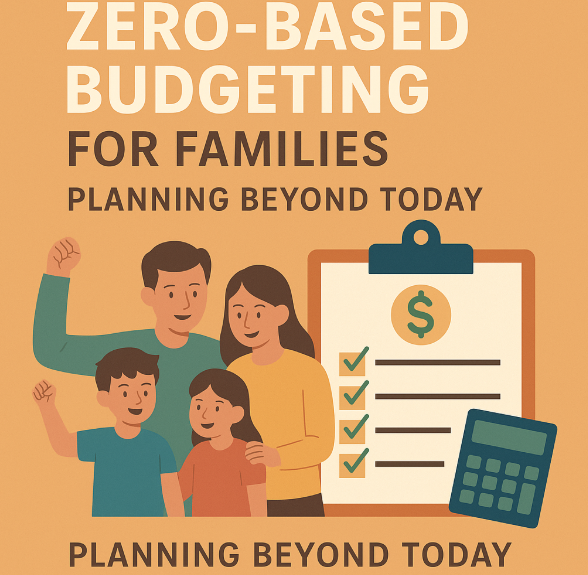Budgeting can feel like a never-ending balancing act for families. Between the mortgage, kids’ activities, rising grocery bills, and saving for the future, money often feels like it disappears the moment it arrives. Many parents find themselves asking: “Where did it all go?”
Zero-based budgeting (ZBB) offers a simple but powerful solution. Instead of just tracking what you’ve already spent, ZBB forces you to give every single dollar a job before the month begins. That shift in thinking can transform your finances from chaotic to intentional — and help your family plan not just for today, but for years ahead.
What Zero-Based Budgeting Really Means
At its core, zero-based budgeting is built around this formula:
Income – Expenses = Zero
That doesn’t mean you spend all your money. It means you assign every dollar a purpose. Some dollars go toward bills, others toward savings, others toward debt repayment or future goals. Nothing is left unplanned, which keeps your budget airtight.
Imagine your family’s income is $5,000 per month. Instead of vaguely hoping you’ll save “whatever is left over,” you give specific instructions for all $5,000 — groceries, utilities, savings, debt, entertainment. At the end of the process, your budget balances to zero.
Why Zero-Based Budgeting Works for Families
Families have dynamic, unpredictable financial needs. That’s exactly why Zero-based budgeting (ZBB) shines. Here’s why it’s different from traditional “set-and-forget” budgeting:
- Prevents overspending. When every dollar is already assigned, there’s no temptation to let “extra” money vanish on impulse buys.
- Anticipates real life. Summer camp? Back-to-school shopping? Holiday gifts? You plan for them instead of scrambling.
- Teaches teamwork. When spouses — and even kids — see where money is going, financial decisions become family discussions, not arguments.
- Provides flexibility. Life changes fast. A child outgrows their clothes, the car needs new tires — you can shift your allocations without blowing the whole plan.
Step 1: Start With Income
Write down your total monthly income from every source:
- Salaries and wages
- Child support or alimony
- Side hustles or freelance work
- Bonuses or irregular payments
Example: The Smith family brings in $5,800 each month — $4,800 from two full-time jobs and $1,000 from a part-time gig.
Step 2: List Out All Expenses
Divide your spending into categories:
- Fixed expenses: Mortgage or rent, insurance, car payments.
- Variable expenses: Groceries, utilities, gas, medical co-pays.
- Non-essentials: Streaming services, dining out, subscriptions.
- Long-term priorities: Emergency fund, retirement contributions, kids’ college savings.
Example: The Smiths spend $2,200 on housing, $600 on groceries, $300 on utilities, and $200 on subscriptions. Writing it down helps them see exactly where the money is going.
Step 3: Give Every Dollar a Job
Now comes the fun (and sometimes tough) part. Assign every dollar until your budget balances.
If you have $5,800 coming in and only $5,500 assigned, that “extra” $300 isn’t free money — it must be directed to savings, debt, or another goal.
Pro Tip: Start with essentials, then allocate toward future goals like debt payoff, college funds, or vacations.
Step 4: Plan Beyond Today
Zero-based budgeting isn’t just about making it through the month — it’s about building security for tomorrow. Families can use ZBB to:
- Build an emergency fund. A cushion for when the car breaks down or someone loses a job.
- Pay off debt faster. Redirect “found” dollars to high-interest loans and credit cards.
- Save for milestones. From braces to birthdays to college tuition, every goal gets a place in the budget.
- Prepare for retirement. Even small contributions add up when started early.
Example: The Smiths assign $250 toward their emergency fund and $200 toward credit card debt each month. In a year, that’s $3,000 saved and $2,400 less debt.
Step 5: Involve the Whole Family
One of the biggest advantages of ZBB is how it fosters transparency. Kids and teens benefit when they see money being planned intentionally.
- For young kids: Let them help “budget” snack money or allowance.
- For teens: Show them how car insurance, cell phone bills, and savings fit into the plan.
- For couples: Schedule a monthly “money date” to review the budget together.
The family that budgets together avoids arguments later.
Step 6: Adjust and Repeat
Life isn’t static, and neither is your budget. Review and reset your zero-based plan every month. If income changes or an unexpected expense comes up, shift the categories but keep the math balanced to zero.
Think of ZBB like meal prepping for your money — you plan ahead, but you can always swap ingredients if life changes.
The Bottom Line
Zero-based budgeting gives families control, clarity, and confidence. By assigning every dollar a job, you eliminate waste, cover today’s needs, and actively prepare for tomorrow’s challenges. Instead of asking, “Where did it all go?” you’ll finally be able to say, “Here’s where it’s going — and why.”
Related Reads:
How to Minimize Debt Later in Life
Estate Planning for Millennials: Why It’s Not Just for the Elderly
Life Insurance and Debt: How to Protect Your Family
Creating an Emergency Fund in Retirement: Why It’s Essential for Protecting Your Nest Egg
Call-to-Action
Gather your family this week, sit down with your numbers, and give zero-based budgeting a try. Even if it feels awkward at first, the clarity and peace of mind you’ll gain are worth it.
